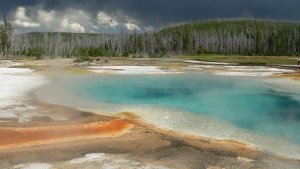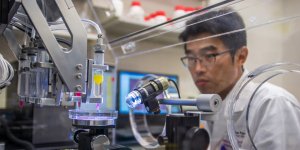Science News
Using a novel, helicopter-borne sensor to penetrate the surface of large swathes of terrain, a team of researchers has gathered compelling evidence that beneath Antarctica's ice-free McMurdo Dry Valleys lies a salty aquifer that may support previously unknown microbial ecosystems and retain evidence of ancient climate change. »
A new, highly detailed ice core reveals a consistent pattern of climate changes that started in the Arctic and spread across the globe to the Antarctic during planet Earth's last glacial period, tens of thousands of years ago. »

A team of University of Utah seismologists has discovered a reservoir of hot, partly molten rock hidden 12 to 28 miles beneath Yellowstone's supervolcano. The pool is over four times larger than a shallower, long-known magma chamber. »
The widespread use of antibiotics in modern society has led to a sharp rise in antibiotic-resistant bacteria. As a result, much research has focused on creating new compounds to fight these bacteria. »
Humans have 2 main types of fat: white and brown. White fat, which tends to be located under the skin and around internal organs, stores excess calories. Too much white fat, a characteristic of obesity, increases the risk of several metabolic disorders. »
After spending more than a month in orbit on the dark side of dwarf planet Ceres, NASA's Dawn spacecraft has captured several views of the sunlit north pole of this intriguing world. »

Smartphones and other personal electronic devices could, in regions where they are in widespread use, function as early warning systems for large earthquakes, according to newly reported research. »

Citizen scientists scanning images from Spitzer Space Telescope, an orbiting infra-red observatory, recently stumbled upon a new class of curiosities that had gone largely unrecognized before: yellow balls. »
After the plains of southern Kenya experienced a severe drought in 2009 that took a terrible toll on wildlife, researchers looked at how 50 wild baboons coped with the drought, and whether the conditions they faced in infancy played a role. »
Bats by the thousands congregate in such caves and mine shafts, spending their winters away from the elements. Their promixity to one another, along with the caves' and mines' natural humidity, has fueled the outbreak of one of the worst bat diseases in history: White Nose Syndrome. »

An extensive study of global habitat fragmentation--the division of habitats into smaller and more isolated patches--points to major trouble for the world's ecosystems. »
Using NASA’s Chandra X-ray Observatory, astronomers have studied one particular explosion that may provide clues to the dynamics of other, much larger stellar eruptions. »
Scientists have found oxygen and oxygen-breathing microbes all the way through the sediment from the seafloor to the igneous basement at seven sites in the South Pacific gyre, considered the "deadest" location in the ocean. »
Researchers have linked a wide array of health effects to air pollution. Among these are reduced lung function, asthma, cardiovascular disease, preterm birth, and even death. The period between 11 and 15 years of age is particularly important for long-term lung function, as lungs are developing rapidly. »
Based on the characteristics of sound waves transmitted through the atmosphere, scientists can monitor and study the evolution of volcanoes right up until eruptions--and from a safe distance. »
Intense hurricanes possibly more powerful than any storms New England has experienced in recorded history frequently pounded the region during the first millennium, from the peak of the Roman Empire to the height of the Middle Ages. »

A food allergy occurs when the immune system reacts to a harmless food as if it were a threat. Symptoms can range from upset stomach and diarrhea, to hives and itching, to tightening of the throat and trouble breathing. Peanuts are one of the most common foods that cause allergic reactions. »
Skin is a barrier that serves as one of the body’s first lines of defense against harmful microbes. Specialized immune cells within skin tissue help to fight invading organisms. Yet the skin hosts diverse communities of beneficial bacteria, collectively known as the skin microbiota. These microbes that naturally colonize the skin are referred to as commensals. »
Termites might not top the list of humanity's favorite insects, but new research suggests that their large dirt mounds are crucial to stopping deserts from spreading into semi-arid ecosystems. »
Dwarf planet Ceres continues to puzzle scientists as NASA's Dawn spacecraft gets closer to being captured into orbit around the object. The latest images from Dawn, taken nearly 29,000 miles from Ceres, reveal that a bright spot that stands out in previous images lies close to yet another bright area. »
Calorie restriction is the process of reducing food intake—typically by at least 30% from a normal diet—without malnutrition. This regimen, also referred to as dietary restriction, has numerous health benefits. It can extend the lifespan, can also improve tolerance to certain metabolic stresses to the body. »

An asteroid, designated 2004 BL86, will safely pass about three times the distance of Earth to the moon on January 26. From its reflected brightness, astronomers estimate that the asteroid is about a third of a mile (0.5 kilometers) in size. The flyby of 2004 BL86 will be the closest by any known space rock this large until asteroid 1999 AN10 flies past Earth in 2027. »
Parasitic worms, which infect millions of people and other animals around the world, influence how the immune system responds to diseases like HIV and tuberculosis. »
The standard treatment for newborns whose brains were deprived of oxygen appears to work better than proposed alternatives, according to a new study. »
Weddell seals have biological adaptations that allow them to dive deep--as much as of hundreds of meters--while hunting, but also an uncanny ability to find the breathing holes they need on the surface of the ice. Now, researchers believe they have figured out how they do it--by using the Earth's magnetic field as a natural GPS. »
New research suggests that some of the bacteria that share our human bodies manufacture antibiotics and that these substances may be capable of fighting infection. »

Mark Hersam, a professor of materials science engineering, chemistry and medicine at Northwestern University, has developed a method to separate nanomaterials by size, therefore providing a consistency in properties otherwise not available. »
Scientists have produced the first integrated computational model of reading, identifying which parts of the brain are responsible for such sub-processes as parsing sentences, determining the meaning of words and understanding relationships between characters. »
A map released by NASA's Near Earth Object Program reveals that small asteroids frequently enter and disintegrate in the Earth's atmosphere with random distribution around the globe. Released to the scientific community, the map visualizes data gathered by U.S. government sensors from 1994 to 2013. »
The elephant has long been an important spiritual, cultural and national symbol in Thailand. At the beginning of the 20th century, its numbers exceeded 100,000. Today, those numbers have plunged to 2,000. »
Paleontologists have discovered an almost complete skull of a previously unknown mammal that likely resembled a large modern-day groundhog and lived alongside dinosaurs. »
A group led by Dr. Robert Yolken at Johns Hopkins University has been studying the links between viral infections and brain development. Unexpectedly, the researchers discovered genetic sequences from Acanthocystis turfacea chlorella virus 1, a type of Chlorovirus, which infects green algae. These viruses are common in fresh water, such as lakes and ponds, but weren’t thought to infect humans or animals. »
After more than a decade traveling through space, a robotic lander built by the European Space Agency has made the first-ever soft landing of a spacecraft on a comet. »
Scientists have created a new map of the world's seafloor, offering a more vivid picture of the structures that make up the deepest, least-explored parts of the ocean. »
Lunar Reconnaissance Orbiter has provided researchers strong evidence the moon’s volcanic activity slowed gradually instead of stopping abruptly a billion years ago. Scores of distinctive rock deposits observed by LRO are estimated to be less than 100 million years old. This time period corresponds to Earth’s Cretaceous period, the heyday of dinosaurs. »
Cells in the human body often need to move in particular directions. Cell movement is crucial for embryo development, immune defense, and tissue repair and regeneration. It’s also key in cancer progression, as metastatic cells spread throughout the body. »
Kalahari, the name conjures an arid, almost lifeless expanse, its red, iron oxide sands stretching to the horizon and beyond. Kgala, Tswana natives called it, the great thirst. Kgalagadi, it's also named: the waterless place. »
Our Milky Way galaxy is littered with the still-sizzling remains of exploded stars. When the most massive stars explode as supernovas, they don't fade into the night, but sometimes glow ferociously with high-energy gamma rays. What powers these energetic stellar remains? »
The Ebola virus can cause severe illness and death in people and other primates. The 2014 Ebola outbreak is the largest outbreak in history, with more than 3,600 infections and 1,800 deaths as of the end of August, according to the World Health Organization. The outbreak is the first in West Africa and the first to affect major cities. »
Malaria is caused by the Plasmodium parasite, which is transmitted to people through mosquitoes. More than 40% of the world’s population lives in at-risk regions. Malaria affects about 300-500 million people each year. Most cases can be successfully treated, but nearly 1 million still die of the disease every year, including about 800,000 children under age 5 in Sub-Saharan Africa. »
Paleontologists have identified a new species of titanosaurian, a member of the large-bodied sauropods that thrived during the final period of the dinosaur age, in Tanzania. »
The human genome sequence, published in 2003, has helped researchers identify countless genes involved in health and disease. But genes tell only part of a biological story. Many other types of DNA sequences also have biological function. These regions control gene activity and affect DNA structure, dynamics, and replication. Chromatin, the complex of DNA and protein that forms chromosomes, also affects how genes are expressed (turned on and off). »
A small asteroid, designated 2014 RC, will safely pass very close to Earth on Sunday, Sept. 7, 2014. At the time of closest approach, based on current calculations to be about 2:18 p.m. EDT (11:18 a.m. PDT / 18:18 UTC), the asteroid will be roughly over New Zealand. From its reflected brightness, astronomers estimate that the asteroid is about 20 meters in size. »
In a finding that has implications for life in other extreme environments, both on Earth and elsewhere in the solar system, researchers published a paper confirming that the waters and sediments of a lake that lies 800 meters (2,600 feet) beneath the surface of the West Antarctic ice sheet support "viable microbial ecosystems." »
New research led by NASA and the University of Washington, Seattle, confirms that springtime snow on sea ice in the Arctic has thinned significantly in the last 50 years, by about a third in the Western Hemisphere and by half near Alaska. »
Once every 50 years, more or less, a massive star explodes somewhere in the Milky Way. The resulting blast is terrifyingly powerful, pumping out more energy in a split second than the sun emits in a million years. At its peak, a supernova can outshine the entire Milky Way. »
Bioengineers have created three-dimensional brain-like tissue that functions like and has structural features similar to tissue in the rat brain and that can be kept alive in the lab for more than two months. »

Located in the Brabazon Range of southeastern Alaska, Yakutat Glacier is one of the fastest retreating glaciers in the world. It is the primary outlet for the 810-square kilometer Yakutat ice field, which drains into Harlequin Lake and, ultimately, the Gulf of Alaska. »
NASA research shows Earth's atmosphere contains an unexpectedly large amount of an ozone-depleting compound from an unknown source decades after the compound was banned worldwide. »
A track about one-third of a mile (500 meters) long on Mars shows where an irregularly shaped boulder careened downhill to its current upright position, seen in a July 3, 2014, image from the High Resolution Imaging Science Experiment (HiRISE) camera aboard NASA's Mars Reconnaissance Orbiter. »


